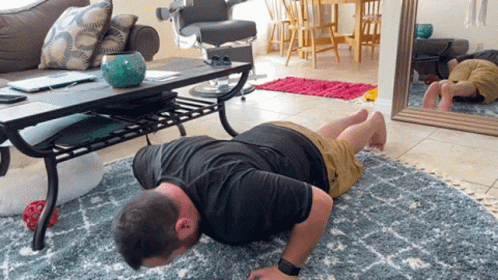
The strength you can’t see... but definitely feel.
You’ve Made It to the Final Phase: Isometric. This one’s the most underappreciated, and I’ll be honest—I’m guilty of not giving it the spotlight in my own training or in my clients’ programs.
But that doesn’t mean it’s not there. I just program it differently:
Take the push-up. Technically, you're holding a plank the entire time. Your body is under isometric tension while your arms go through eccentric and concentric phases. That’s why push-ups can feel way more fatiguing than a heavy bench press.
Sure, you’re applying some isometric force during a bench too; but it’s not the same. The bench supports your body. The push-up? You’re your own support system.
So the next time you’re knocking out push-ups, realize this:
You're resisting gravity (eccentric)
Pushing back up (concentric)
And holding your entire body tight the entire time (isometric)
Simple takeaway?
Do your push-ups.

This is about stillness with tension.
No movement. Just force against resistance.
Let’s get into the Isometric Phase!
"The body like a withered tree, the mind like dead ashes. This is the true stillness, but how hard it is to attain!"
Fact-based news without bias awaits. Make 1440 your choice today.
Overwhelmed by biased news? Cut through the clutter and get straight facts with your daily 1440 digest. From politics to sports, join millions who start their day informed.
THE BREAKDOWN
What Is The Isometric:
An isometric contraction happens when your muscle holds tension without changing length.
There’s no up or down; just steady, and maybe some brutal control.
Examples:
Holding a plank; keeping your torso upright during a load squat
Pausing at the bottom of a squat
Squeezing your fists or pushing against an immovable object
This is the “pause” phase of strength.
Why Is It So Important:
Improves Joint Stability
Great for injury-proofing, especially around knees, shoulders, and spine.
Builds Position-Specific Strength
Hold the exact position you’re weak in. Then make it your strongest.
Mental Toughness + Body Control
It’s just you vs. gravity or an unmovable object. Teaches patience, control, and pain tolerance.
Transfers to Sports & Life
Whether you’re scrambling in a grappling match or bracing for a hit… holding strong matters.

Walking Overhead Carries
Types & How To Implement:
Pause Training
Find a spot where the most tension is in a normal loaded exercise and pause.
Squat and hold just above the bottom.
Bench and pause just off the chest.
Own the “sticking points.”
Yielding Isometrics
Hold a position under load for time.
Try: Wall sits, planks, lunge holds, suitcase holds.
Overcoming Isometrics
Push/pull against an immovable object. Max intent.
E.g., deadlift bar into pins, or press into a wall.
Positional Holds in Sport Context
Plank under tension, single-leg balances, isometric grappling holds.
Anything sport specific
Drill Of The Week:
Isometric Split Squat Hold
-Back knee 1–2” off the ground
-Hold for 20–30 sec each leg
-3-5 rounds
*Tears up your legs, lights up your core, improves posture under fatigue*
So. Are You Ready to Train Smarter, Get Stronger, and Actually See Results?
If you’ve been enjoying the value in these weekly drops, imagine what we can do together with a fully customized plan built for your goals, your schedule, and your life.
👉 Online Coaching + Programming — just $99/month
You’ll get:
Personalized strength & conditioning built around you
Accountability, progress tracking, and ongoing adjustments
Direct access to me for feedback, support, and strategy
Refer a friend, and both of you get it for just $69/month for the first 90 days.
💪🏼Train with a partner. Save together. Win together.
And here's the no-BS guarantee:
Give me 12 weeks. If you don’t see real progress toward your goals, I’ll coach you for free until you do.
Results, or I stay in the fight with you until we get them.
COACH’S INSIGHT
I do think strictly isometric work should be limited, unless your sport/activities call for it. It is great to incorporate here and there, but I tend to pair it with a dynamic movement. Short pauses within lifts and full movements do wonders. This way, you’re also hitting all three phases.
But at the end of that day, isometric work is great! Especially for enhancing grip and conntective tissue strength. Plus, increasing muscle fatigue ceiling (helping you hold on longer).
I would just not dedicate entire sessions or body parts to only isometric work. It’s awesome for supporting the main two phases.

See You Next Week! We’ll be back to issues about various topics.
If you’ve made it this far, I’m assuming you’re finding some value in this week’s newsletter; and that’s exactly my goal!
If it’s not too much to ask, go ahead and share it with a friend or someone you think would appreciate it too!
It would mean a lot. Thank you.

I appreciate you taking the time to read my newsletter!
Thank you,
Stephen Holmes Founder, Linking Performance & The Weekly Standard
→ Follow on Instagram @linkingperformance
→ Follow on X (Twitter) @Link_Pformance


